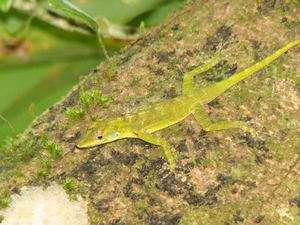Advertisement
Published: January 19th 2011

 Lizard
Lizard
These little guys are found everywhere in the forest.El Yunque National Forest is the only thing on today’s agenda.
El Yunque National Forest is located on the Caribbean Island of Puerto Rico in the Greater Antilles group. The El Yunque National Forest is the sole tropical rain forest in the U.S. National Forest System. The forest’s relatively small 28, 000 acre size belies its importance. It differs significantly from all the other U.S. National Forests because of its year-round tropical climate and immense biodiversity. The Luquillo Mountains rises to 3,533 ft. above sea level comprise most of the forest land. Their steep slopes can sometimes receive rainfall of over 200 inches (508 centimeters) at higher elevations. The rain forest is noted for its biodiversity; it is “home” to thousands of native plants including 150 fern species, 240 tree species; 88 of these are endemic or rare and 23 are exclusively found in this forest. It was established as the Luquillo Forest Reserve on 17 January 1903 by the General Land Office with 65,950 acres, and became a National Forest in 1906. The name “El Yunque” is from an Indian spirit named Yuquiye. The Taino Indians, the original inhabitants of Puerto Rico, believed that gods lived in the highest peaks

 Snails
Snails
These guys can be found attacthed to almost anythingof the mountains of the forest. Yuquive was the god which protected the island from the angry god (hurricanes).
The most common geologic parent material is marine-deposited Cretaceous volcanic rock, alluvial deposits are found near the major water flows and intrusive quartz diorites on the south side of the forest, the forest soils are 50%-80% clay and since the excessive moisture does not evaporation, the soils are saturated and erodible. In fact, landslides are common and constant preventative maintenance is necessary to control the problem. Within the forest, the Puerto Rican parrot (Amazona vitatta) resides. This parrot is on the top ten most endangered species. The reason that this parrot is now on the endangered list is its loss of habitat. The remaining parrots live in the highest mountains of the forest; have green bodies, red foreheads, blue wings, and beige feet. I did not see any but I’m sure they are hiding away in there, somewhere. You could though hear the famous coqui frog chirp throughout the forest. This is the island national mascot.
Within the forest is Yokahu Tower. It is basically an observation tower in which you can see marvelous sites from all directions and is about

 Flora
Flora
The different kinda of flora found here varies greatly from color, size, and type.8 stories high. The Indians named the tower after what was known as the god of good and was used in times of defense as a lookout tower for those entering San Juan via ocean. The tower would send up a signal which would reach the forts at San Juan to look out and prepare for the defense.
Advertisement
Tot: 0.147s; Tpl: 0.032s; cc: 10; qc: 50; dbt: 0.0805s; 1; m:domysql w:travelblog (10.17.0.13); sld: 1;
; mem: 1.1mb

 Lizard
Lizard
 Snails
Snails
 Flora
Flora












